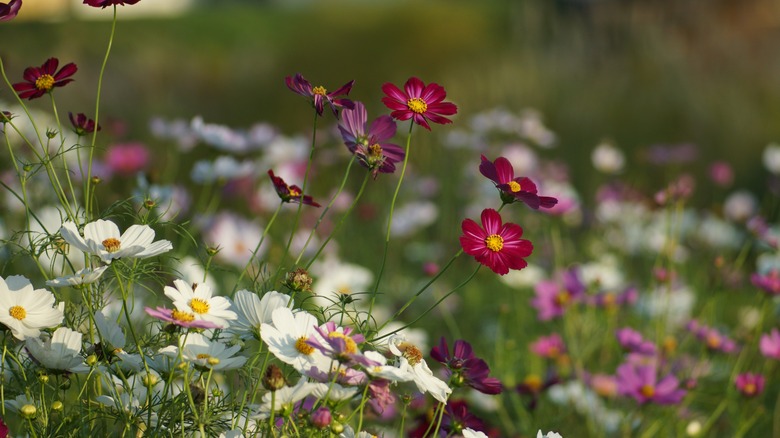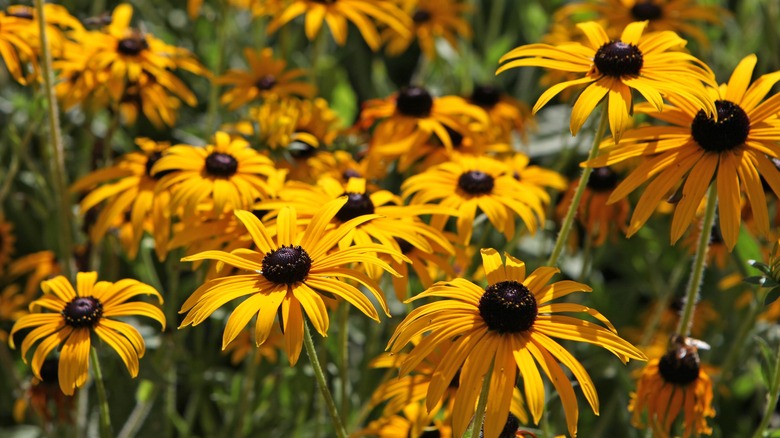Some plants just don’t work well together. There could be compatibility issues if plants have completely different requirements, like how types that need wet soil won’t do well next to species that need dry soil. Other plants can’t cope with certain species because they’re allelopathic and release chemicals into the soil that kill surrounding plants, like black walnut trees or sunflowers. When it comes to cosmos (Cosmos bipinnatus) and black-eyed Susan (Rudbeckia hirta) sharing a space, it’s the height difference that can cause problems.
Cosmos plants can be grown in both flower and edible gardens. They attract many pollinators, showcase elegant blooms, and have thin stems. These characteristics will add interest since they typically stand out against the other plants in a garden. But when you put them right next to short and sun-loving plants like black-eyed Susan, they take up all the sunlight and will choke out their neighbors. You can certainly have both of these flowers in the same garden bed, but you’ll need to be strategic with the layout so that everyone stays happy.
Why cosmos and black-eyed Susan aren’t good neighbors

Cosmos and black-eyed Susan are wildflowers you’ll often find in the same seed mixes. They both love the sun and tolerate drought conditions, so it’s no wonder they’re often put in the same bag. However, cosmos can easily shade out black-eyed Susan since the stems can reach up to 7 feet tall, making them unfortunate neighbors. Black-eyed Susan flowers barely reach half of that, often only growing to be about 2 feet tall. If these blooms are surrounded by towering cosmos, they’re likely to not survive.
Another reason why these plants may not be good neighbors is because black-eyed Susan can’t provide cosmos with the support it needs. Cosmos plants do best when they have some kind of support for their tall, lanky stems. A harsh gust of wind can bend the flowers over so much that their stems break. You could take the time to support them with stakes or you could use other tall flowers as a natural and convenient way to hold them up. Black-eyed Susan blooms aren’t a good support system since they’re much shorter. Spider flowers and ornamental grasses are a couple examples of the plants you should put next to your cosmos, as these are both tall and supportive.
How to use cosmos and black-eyed Susans in the same space

While black-eyed Susan and cosmos flowers may not be ideal for planting right next to one another, that doesn’t mean they can’t be placed in the same garden bed. In fact, placing them near each other could actually be beneficial, since they have most of the same care requirements. If you do decide to plant cosmos and black-eyed Susan in the same garden bed, try to plant them so that the short flowers will still receive ample sunlight. Though black-eyed Susan flowers enjoy a lot of sunlight, they can benefit from afternoon shade in the heat of summer. Plant them to the east of your cosmos so they can benefit from sunlight until the sun is in the west. Cosmos will also benefit from this setup since they like as much sunlight as they can get.
At the same time, black-eyed Susan can become somewhat weedy and may be invasive if it doesn’t have flowers to compete with. The flowers will quickly fill up a flower bed and take over smaller plants. If your Susans are overstaying their welcome, add some cosmos into the mix. They’ll shade out some of the flowers and will help you get your flower bed back to a diverse state that isn’t overrun with only black and yellow blooms.



